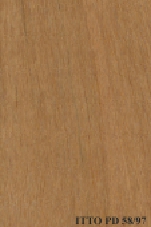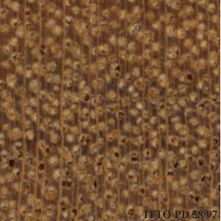
RIKIO (Uapaca guineensis)
Trade Name
Rikio
Scientific Name
Uapaca guineensis Muell.Arg.
Family
EUPHORBIACEAE
Common Names
Koondi (Sierra Leone); Koudi (Guinea); Kobotoue (Guinea); Rikio (Côte d`Ivoire); Bosenge (Zaire); Assam (Gabon); N'sanvi (Congo); Assam (Cameroon); Yeye; Yere; Voapaca; Umpwenek; Tuo-le; Tshilengu; Tiom`bi; Sugar plum; Suang; Somon; Somo; Some; Sofiro; Soang-nasa; Shasun; Senchi; Rikio; Red cedar; Oyen; Orobo; Oriang; Oreng; Onye; Okon; Obubit nkpenek; Obia; Nsanvi; Nja-kundi; Nere-kere; N`nan; Mutakale; Mulengu; Mukusu; Mole; Me-kundi; Kwintan; Kuntan; Kuntad; Kundi; Kulil; Koondi; Kondii; Kondi; Koe-lil; Kindi; Kayo; Kajafogo; Kahio; Kahie; Kafafogo; Kafaffago; Kaango; Jagale; Ishase; Ile; Gondi; False mahogany; Emido; Elekhua; Elehowa; Edan; Dumbe; Dombe; Bou-rikio; Bosenge; Borikio; Biyo; Be-yo; Assam; An-lil; Alokoba; Alokaba; Alohua; Alohowa; Alobo; Alebie; Alaba; Abo
Scientific Name Synonyms
Uapaca paludosa Aubrev. & Leandri; Uapaca bingervillensis Beille
Description Of The Tree
Botanical Description
The tree reaches a height of 20 to 30 m. The bole may be up to 13 m in length, with high stilt roots. The trunk diameter attains 70 cm.
Natural Habitat
Uapaca guineensis is abundant in swampy regions, sometimes found also in the savanna forests.
Natural Distribution
West Africa.
Wood Identification
Anatomic Description Of Wood
Wood diffuse porous. Occasionally vessels exclusively solitary (over 90%). Tangential diameter of vessel lumina 150 to 200 micras (medium). Tyloses thin walled. Vessels per mm2 10 to 20 (abundant). Simple perforation plates. Scalariform perforation plates with Apotracheal axial parenchyma diffuse and/or diffuse in aggregates. Paratracheal axial parenchyma scanty and/or vasicentric. Non-crystals in axial parenchyma cells. 5 to 8 cells per parenchyma strand. 4 to 10 rays per mm (medium). Rays of two distinct sizes. Rays non-storied. Larger rays more than 4 seriate. Rays exclusively uniseriate. Silica bodies in the ray cells. Heterogeneous rays and/or multiseriate heterogeneous rays. Non-septate fibers. Fibers with simple to minutely bordered pits.
-
 Wood Macro Photo Tangential Plane
Wood Macro Photo Tangential Plane
-
 Wood Micro Photo Of Transversal Section
Wood Micro Photo Of Transversal Section
Availability
Cites Status
Unrestricted
General Wood Description
Color
The sapwood is paler than the heartwood. The heartwood is pale red to red-brown, it is not clearly demarcated.
COLOR INDEX (1=Black, 7=Light yellow,white)
4
Grain
Straight or slightly interlocked, sometimes with an influence on further processing operations.
Texture
This species is usually reported to have a coarse texture.
Luster
The wood is described as moderate in luster.
Natural Durability
Very durable to decay; without preservative treatment. This species is especially suited for all the uses with risks of permanent or long-lasting humidification. Resistant to termites attack. Heartwood is resistant to Lyctus attacks.
Natural durability index (1= Very high durability, 7=Vey low durability)
1
Internal Growth Stresses
For this species no growth stresses are reported.
Resistance To Impregnation
Nearly impossible to treat with a too much low penetration of the preservative substances.
Wood Physical Properties
Basic Density or Specific Gravity (O.D. weight/vol. green) (g/cm³)
0.59
Air-dry Density (Weight and volume at 12%MC) (g/cm³)
0.66
Total shrinkage Tangential (Saturated to 0%MC) (%)
9.3
Total shrinkage Radial (Saturated to 0%MC) (%)
4.6
Recommended Dry Kiln Schedule
FR-11
Dimensional stability ratio (Total Tangential Shrinkage %/Total Radial Shrinkage %)
2.0
Wood Chemical Properties
Wood Mechanical Properties
Bending Strength (MOR),12%MC (kgf/cm²)
929
Stiffness (MOE) 12%MC (kgf/cm²)
140116
Compression parallel to fiber 12%MC (kgf/cm²)
511
Compression perpendicular to fiber 12%MC (kgf/cm²)
64
Shear strength radial 12%MC (kgf/cm²)
76
Janka hardness (side) 12%MC (kgf)
531
Janka hardness (end grain) 12%MC (kgf)
632
Workability
Sawing
It is easy to saw.
Rotary Veneer Cutting
Not suitable for veneering.
Sliced Veneer
Not suitable for veneering.
Blunting Effect
Moderate blunting effect; stellited blades for sawing and carbide tools for machining are advised.
Machining
Possible difficulties caused by interlocked grain are reported.
Planing
Easy; no particular problems.
Moulding
Moderately easy; tools must be cautiously sharpened.
Boring
Moderately easy; tools must be cautiously sharpened.
Mortising
Moderately easy; tools must be cautiously sharpened.
Nailing
Pre-boring is necessary.
Gluing
Glues well if basic gluing technical rules are followed.
Sanding
Easy to perform; it gives good results.
Polishing
Needs pre-coating.
Response To Hand Tools
No particular problems.
REFERENCED USES
End Uses Summary
HOUSING GENERAL, beams, joists, boards, flooring, parquet, steps, CONTAINERS, truck bodies, truck flooring, OTHER AND MUSICAL INSTRUMENTS, axle
General Housing
- 10 - Silica in Timbers
Beams
- 11 - Prospect: The wood database
Joists
- 12 - Tropical timbers of the world. Part I-Tropical American Species
Boards
- 13 - Dry kiln schedules for commercial woods. Temperate and tropical. Section III. Latin American (Mexico, Central, and South America) Woods–Conventional Temperatures
Flooring
- 14 - Handbook of Hardwoods
Parquet
- 15 - Empire Timbers
Steps
- 17 - Tree Conservation Database
Truck Body
- 53 - Timbers of the New World
Truck Flooring
- 54 - Bulletin of the Government Forest Experiment Station N.157: Identification of Tropical Woods
Axles
- 73 - Handbook of Hardwoods
Please Provide Information To View Producer Information